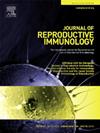miR-146a-3p激活TLR7在抗磷脂抗体诱导的滋养细胞IL-8和炎症小体介导的IL-1β产生中的作用
IF 2.9
3区 医学
Q3 IMMUNOLOGY
引用次数: 0
摘要
患有抗磷脂抗体(aPL)的妇女妊娠并发症的风险很高。在产科抗磷脂综合征(APS)中,针对β2糖蛋白I (β2GPI)的aPL靶向胎盘滋养细胞导致炎症。我们小组的研究表明,aPL通过激活toll样受体(TLR) 4触发滋养细胞产生升高的炎性IL-1β和IL-8,而下游,IL-1β是由尿酸诱导的NLRP3炎性体激活介导的,IL-8是由一种新的tlr8激活microRNA (miR) miR-146a-3p介导的。本研究的目的是进一步探讨TLR7-和tlr8 -激活miRs在apl驱动的滋养细胞趋化因子和炎性小体反应中的作用。利用人妊娠早期滋养细胞系Sw.71,我们发现aPL提高了miR-146a-3p的表达,但对miR-21a、miR-29a或Let-7b的水平没有影响。apl诱导的滋养细胞IL-8分泌被TLR7抑制剂IRS661和TLR8抑制剂CU-CPT9a降低,而apl诱导的尿酸、caspase-1活性和IL-1β分泌仅被TLR7抑制剂降低。使用特异性miR模拟miR过表达miR-146a-3p以TLR7和tlr8依赖的方式诱导滋养细胞IL-8分泌,而miR-146a-3p仅通过TLR7诱导滋养细胞IL-1β分泌。这项研究强调了TLR7/ tlr8激活miR-146a-3p作为一个中间信号的作用,它有助于和调节上游tlr驱动的滋养细胞炎症反应,并增加了我们对支持产科APS发病机制的分子和先天免疫机制的认识。本文章由计算机程序翻译,如有差异,请以英文原文为准。
A role for TLR7 activation by miR-146a-3p in antiphospholipid antibody-induced trophoblast IL-8 and inflammasome-mediated IL-1β production
Women with antiphospholipid antibodies (aPL) are at high risk for pregnancy complications. In obstetric antiphospholipid syndrome (APS), aPL specific for beta2 glycoprotein I (β2GPI), target the placental trophoblast leading to inflammation. Studies from our group have shown that aPL trigger trophoblast cells to produce elevated inflammatory IL-1β and IL-8 via activation of Toll-like receptor (TLR) 4, and that downstream, IL-1β is mediated by uric acid-induced NLRP3 inflammasome activation, and IL-8 is mediated by a novel TLR8-activating microRNA (miR), miR-146a-3p. The objective of this study was to further explore the role of TLR7- and TLR8-activating miRs in the aPL-driven trophoblast chemokine and inflammasome response. Using the human first trimester trophoblast cell line, Sw.71, we found that aPL elevated miR-146a-3p expression but had no effect on levels of miR-21a, miR-29a or Let-7b. aPL-induced trophoblast IL-8 secretion was reduced by the TLR7 inhibitor, IRS661, and by the TLR8 inhibitor, CU-CPT9a, while aPL-induced uric acid, caspase-1 activity, and IL-1β secretion was reduced only by the TLR7 inhibitor. Over expression of miR-146a-3p using a specific miR mimic induced trophoblast IL-8 secretion in a TLR7- and TLR8-dependent manner, while miR-146a-3p induced trophoblast IL-1β secretion only via TLR7. This study highlights a role for TLR7/TLR8-activating miR-146a-3p as an intermediate signal that contributes to and modulates upstream TLR-driven trophoblast inflammatory responses, and adds to our knowledge of the molecular and innate immune mechanisms that underpin the pathogenesis of obstetric APS.
求助全文
通过发布文献求助,成功后即可免费获取论文全文。
去求助
来源期刊
CiteScore
6.30
自引率
5.90%
发文量
162
审稿时长
10.6 weeks
期刊介绍:
Affiliated with the European Society of Reproductive Immunology and with the International Society for Immunology of Reproduction
The aim of the Journal of Reproductive Immunology is to provide the critical forum for the dissemination of results from high quality research in all aspects of experimental, animal and clinical reproductive immunobiology.
This encompasses normal and pathological processes of:
* Male and Female Reproductive Tracts
* Gametogenesis and Embryogenesis
* Implantation and Placental Development
* Gestation and Parturition
* Mammary Gland and Lactation.

 求助内容:
求助内容: 应助结果提醒方式:
应助结果提醒方式:


